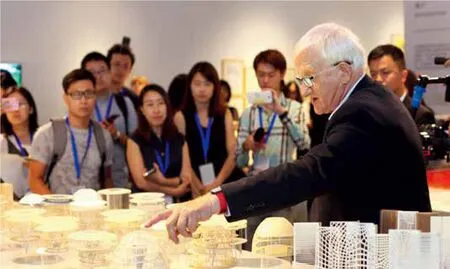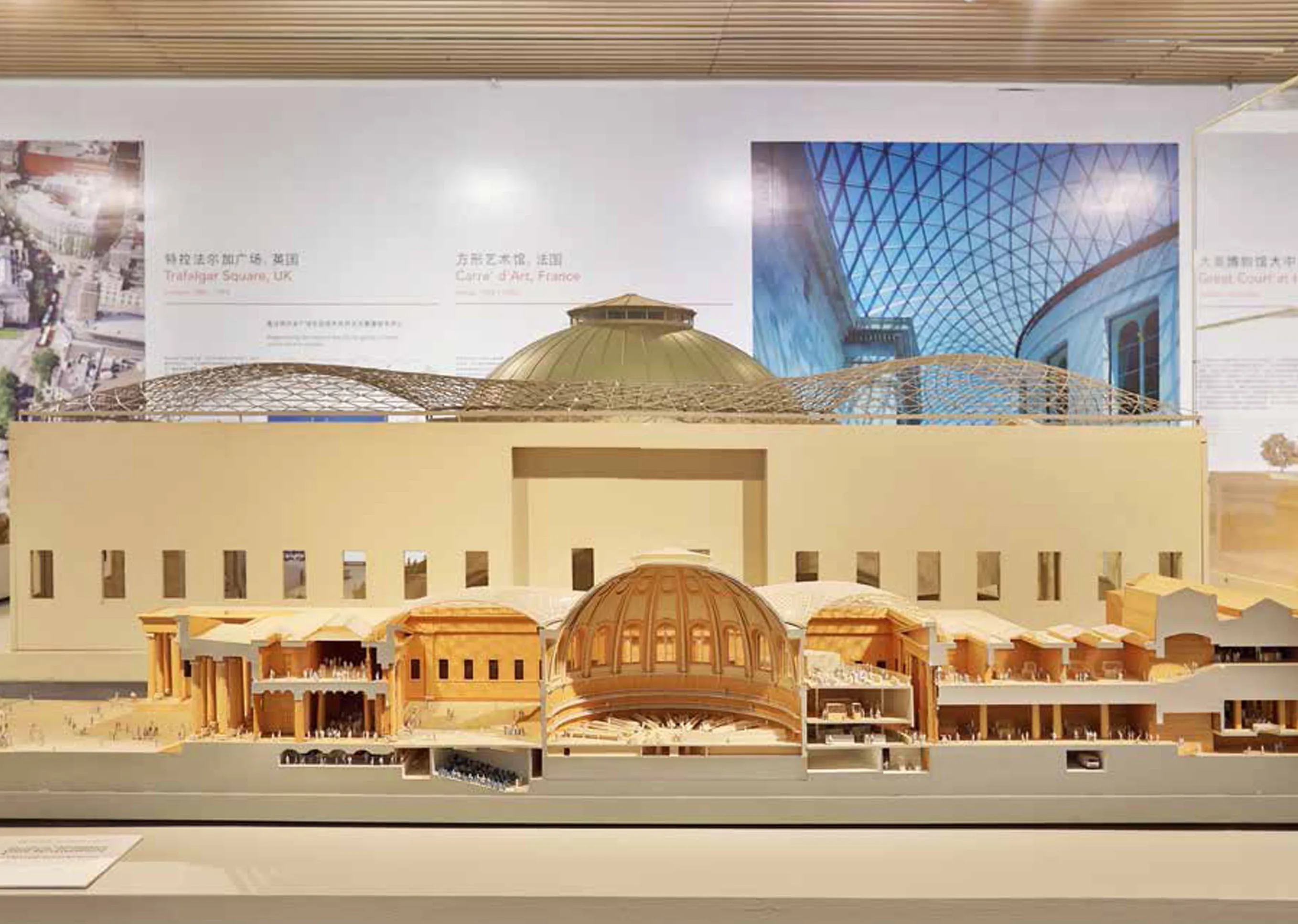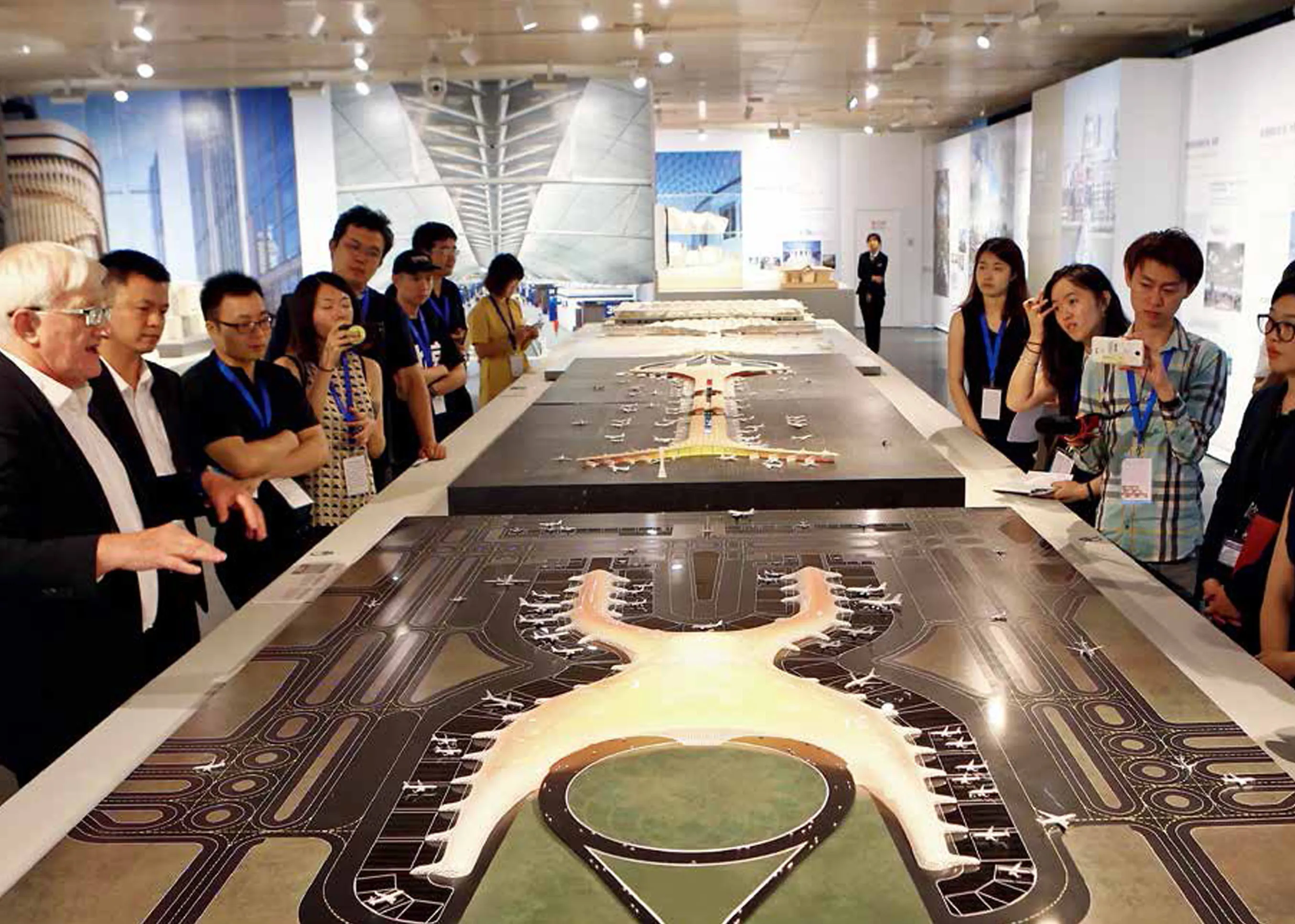格雷·说城市
2018年7月24日,由英国福斯特及合伙人建筑设计事务所“可持续人居|共享的未来”展览在清华大学艺术博物馆开幕(图1—图4)。斯宾塞·德·格雷先生接受了本刊记者专访。
Q1智慧城市建设中如何体现城市设计的作用?
我认为城市设计包含很多方面的特点,也具有很多要素。例如宜居的城市空间既要有智慧城市的技术要素,又要有一定的创造性要素。它们之间有一个平衡点,我们应当非常谨慎地寻找到两者之间的平衡点。因为如果其中一种方法以牺牲另一种方法为代价占了上风,那么另一种方法就没有完美的解决方案。所以我认为,探索空间本质是非常必要的,无论建筑之间还是广场和街道,这在任何城市都很重要。这些空间的质量如何?它们到底是不是好的空间?
这说起来很容易,但实现起来要困难得多。所以,在开始设计工作之前,我们要对这些空间进行足够的分析,了解人们如何在空间中移动,了解日照的质量或是缺少日照的状况,了解建筑的朝向、地区的风向等。所有这些可以客观分析的品质对于一个成功的设计来说是非常重要的。在此基础上提出智慧城市才是正确的,将智慧技术整合到城市肌理中也是非常重要的。
这包括,使用电动汽车而不是耗油量大的汽车,管理行人和车辆之间的关系等,使城市设计对能源和环境的影响找到新的平衡。也就是说,城市设计是一个非常复杂的问题,这也正是我们派出一个强大的城市设计团队来应对每个城市设计项目的原因。但如果不将智能技术的相关方面整合到当前的城市设计中,那就太疯狂了。因此,我认为这是一个在两者之间取得平衡并以一种成功方式整合它们的问题。
Q2在城市可持续发展的过程中,城市设计对保护和传承历史文化具有什么样的作用?
我们一直很感兴趣的主题之一就是新旧关系。我认为一个成功的城市设计是尊重过去的,但绝不是在旧的上面束缚手脚,而是在过去的基础上进行建造。一些事件会影响了过去的空间,特别是比较近的过去,那么引入新的元素,建立在旧的空间之上,并把空间变成更新的当代城市的一部分。
我总是谈论要保持平衡。如果过去是值得保留,那么忽视它就是疯狂之举。建立在过去的基础上,引入新的元素,为特定的片区或街道或各种场所带来新的生活。这种原则对于历史建筑来说同样成立,我们对建筑和城市设计采取完全一样的态度和做法。

图1 / Figure 1 2018年7月24日,斯宾塞·德·格雷先生在清华大学艺术博物馆进行导览Mr. Spencer de Grey in Tsinghua University Art Museum,Beijing, China, July 24, 2018来源 / Source: Foster + Partners
Q3针对中国当前的城市发展状况,您对开展城市设计有何建议?
中国的城市发展得很快,人们也有很多想法。如果你做错了,你就会花很多钱,而不能为居住在那个地区和工作在那个地区的居民投资来改善他们的环境。我认为这很有趣,并且我认为人们对我们之前所说的一切都很感兴趣。对我来说,这样的问题一遍一遍地强化,那就是当我在城市里散步时,我所经历的是什么样的环境?如果你和这个房间里的人交谈,谈起他们真正喜欢散步的环境,大概是两旁有四至六层建筑的街道,那里有热闹的商店、咖啡厅、餐馆、文化设施、街头茶座。
这样的空间就是一个居住空间和办公空间的丰富组合,我认为这是一个很好的起点,一个大的城市场景的横截面。如果人们说:“我们要把这个街区变成住宅区,把那个街区变成办公楼,把那个街区变成购物区”,一切都划分开了,那么这个场景就变味了。我认为城市,无论在中国、在欧洲或是在其他的地方,在那些历史悠久、充满活力的城市中,你不能把这些功能区分开,它们都是混合在一起的,这样人们才能去享受。他们可以去一家商店楼上的一间办公室,然后再进入公寓上面一个商店,等等。
当这些都交织在一起的时候,我认为这就形成了一个很好的起点,并且我认为这些问题需要非常仔细地讨论,这也是一项艰巨的任务。每个城市都应该有一个完整的系统,你要类比不同的城市,并明白是什么让这个城市运转起来。通过回溯历史,了解这个城市是如何演变,那些街道和商店是怎样形成的,等等,并从中学习。研究所有这些东西以及思考如何把这些东西转换成另一种对象,这就是城市设计应该做的工作。
的确,现在我们面临一个积极的环境。在中国和世界各地,智能城市正开始变成一种潮流。高楼大厦往往只是落在街道网格上,人们说这就够了。但这些城市与纽约是不同的,那里有适当的街道,有独立的建筑,有更多的空间。所以空间有可能性,它存在于一切事物中,那里到处都是高密度的。因此,如果我们试图填满这个强大的城市,我认为人们不得不对这些问题提出质疑。
如果建筑有四到五层楼高,就会产生更多好的空间。它们被非常仔细的组织,它们的高度提供了最大的阴影。街道很狭窄,但除了街道以外,显然也有步行区域和广场。与此同时,我们在高速公路上使用了一系列的高科技,并对更多的城市空间进行了改造。这将给城市带来一系列新的优势,再加上向中国传统城市空间最好的方面进行学习,并将它们结合在一起。
在某种意义上这将形成一种不同的新模式,它与历史的内容密切相关,并与优秀的当代设计联系在一起。我认为这两者之间没有冲突。我认为你可以把这些元素混合在一起,这一定是非常不可思议的,我想我们会设计出很多更好的空间。建筑的未来也会从很多想法中浮现出来,但直到你开始谈论建筑本身,它才会变得特别。解决方案是否与问题契合?显然,画出一幅图景是很容易的。所以我仍然认为,探讨这些问题是非常重要的。
ORIGINAL TEXTS IN ENGLISH
[U-TALK]
Spencer de Grey·TALK about City
[Interviewee]Spencer de Grey
[Date]July 24, 2018
[Place]Beijing, China
[Interviewer]YANG Tao, SHANG Qian
Spencer studied at Cambridge University, joining the practice in 1973. He set up Foster + Partners' Hong Kong office in 1979 for the Hongkong Bank project,returning in 1981 to work on Stansted Airport and the Sackler Galleries at the RA. Since then he has worked on a wide range of cultural, civic, education and masterplan projects, including the Great Court, the Sage and MFA Boston. He is visiting Professor of Design at Cambridge University and a Royal Academician.
He is a visiting professor of design at the University of Cambridge, and the president of the Building Centre Trust. He also lectures widely. In 1997 he was made a CBE in the Queen's Birthday Honours List and in 2008 was elected a Royal Academician of the Royal Academy of Arts. (Figure 1).
Source: https://www.fosterandpartners.com.

图2 / Figure 2大英博物馆大中庭模型Models of the Great Court, the British Museum来源 / Source: Foster + Partners
Q1 What is the role of urban design in building smart city?
Well, I think urban design has many aspects,many features to it, and there's a balance between smart cities technologies and creation of good public space and good cities to live in. I think the two approaches have to be quite carefully balanced, because if one gets the upper hand at the expense of the other, one hasn't got the perfect solution. So the exploration of the nature of spaces between buildings, the squares, the streets,of any city, I think, is incredibly important, and the quality of those spaces, and are they good spaces to be, or are they not?
That is very easily said, but is much more difficult to achieve. So, the analysis of those spaces before one starts working, understanding how people move through the spaces, the quality of sunlight or the lack of sunlight, the orientation, the wind, all the qualities that one can analyse objectively are very important in terms of informing a successful piece of design. But then you're right to raise the smart city, so the integration of smart technology into the urban fabric is also incredibly important.
You know, the use of electric vehicles rather than gas-guzzling vehicles, how you manage the relationship between pedestrians and vehicles,getting that balance right, the energy, the environmental implications of urban design. I mean,urban design is a very complex issue, and it's no surprise that we have a strong urban design team working in the office on our urban design projects. But it is crazy not to integrate the relevant aspects of smart technology into current urban design. So, I think it's a question of getting the balance between the two, and integrating them in a successful way.

图3 / Figure 3斯宾塞·德·格雷先生进行导览Mr. Spencer de Grey introducing the exhibition来源 / Source: Foster + Partners
Q2 How does urban design contribute to the conservation and evolvement of historic culture in the process of urban sustainability?
So, one of the themes that we have always been very interested in is the relationship between old and new. I think a successful piece of urban design is respectful of the past, but not having one's hand tied to the past, but building on the past. And then if events have taken place that make aspect of the past, particularly the most recently past, introducing new elements that built on the past, and transforming the space into an updated contemporary piece of city.
I'm taking always about balance, if the past is worth keeping, it is mad getting rid of it. And so building on the qualities of the past, but introducing new elements to bring new life to the particularly district or street of whatever it might be. With our principles, when we comes to look at historic buildings, we do exactly the same with no difference for buildings and urban design.

图4 / Figure 4展览场景The Exhibition来源 / Source: Foster + Partners
Q3 Do you have any suggestions on urban design according to the current development of Chinese cities?
China's cities are growing fast. I think that there's a lot of thought because if you get that wrong, you're spending a lot of money and not preparing to invest in the environment for citizens who are living in that district and working in that district.
I think it's quite interesting, and I think they've been quite interested in all of what we have been said. For me, it comes back over and over again to strength therefore, on what is the environment like that I experience as I walk round your city. If you talk to people in this room, and say what they really enjoy walking around, sort offour, five, six storey streets which have lively shopping, cafes,restaurants, cultural facilities, street cafes.
I mean, it's a rich mix of residential and office accommodation, which I think that is quite a good starting point for a cross-section of a big urban scene. That scene starts to go elsewhere if people say, “We'll make this city block just residential,and that city block just offices, and that city block just shopping,” and it's all compartmentalised. I think the cities, the historic cities that you enjoy and go to visit, either in China or in Europe or wherever, are the ones where you can't really distinguish between any of those things, they are all just mixed, and people go to enjoy them and they go up to an office above a shop and then they got into a door and they go into their flats above a shop or whatever.
It's all intermingled, and I think that's a very good starting point. I think those issues need to be talked about very carefully. It's a huge undertaking because every city should have a full system.You may compare different cities, and as long as you understand what makes that city tick. That is,going back in time finding what the history was and understanding how the city evolved, and how those shops and streets and all that were formed,learning from that. Study all those things and seeing how that can be translated into an alternative object, and that's what urban design should do.
But really it's a positive environment, I think, in China and various places round the world where smart cities are beginning to be just a sort of trend. High-rise buildings just dropped onto to a grid of streets, and people say that's enough. But it isn't like New York, where you've got proper streets and individual buildings, and there are more space there. So there's lots of possibility of space, it's in everything. It's all very high-density.Therefore, if we're trying to fill this strong urban space, I think one has to question that.There are more good spaces if the buildings are four and five storeys tall. They are very carefully organised, and there are height to provide the maximum of shade. The streets are very narrow,where there are streets, but obviously there are also pedestrian areas and squares. At the same time, we uses a whole range of high technology that serves the highways or, reinvented more urban space. This bring a whole range of new advantages, learning from the best aspects of status in China and pulling them together.
It will be a new different module in a sense linked with historical aspects, and linked with good contemporary design. I don't see a con flict between them. I think you could mix those elements together, that's amazing and I think we'll design better spaces. The future of the building emerges out of a lot of ideas, but it's not until you start talking that the buildings themselves come out of particular. Does the solution fit the problem? It's de finitely easy to paint a picture. So I still think it's important to discuss all these issues.

